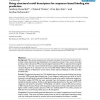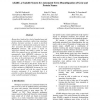42 search results - page 2 / 9 » Automatically extracting functionally equivalent proteins fr... |
ISMB
1997
13 years 6 months ago
1997
1 W’edescribe a novel approach for predicting the function of a protein from its amino-acid sequence. Given features that can be computedfrom the amino-acid sequence in a straigh...
BMCBI
2007
13 years 5 months ago
2007
Background: Many protein sequences are still poorly annotated. Functional characterization of a protein is often improved by the identification of its interaction partners. Here, ...
BMCBI
2006
13 years 5 months ago
2006
Background: Methods for predicting protein function directly from amino acid sequences are useful tools in the study of uncharacterised protein families and in comparative genomic...
CSB
2004
IEEE
13 years 9 months ago
2004
IEEE
Researchers, hindered by a lack of standard gene and protein-naming conventions, endure long, sometimes fruitless, literature searches. A system is described which is able to auto...
BMCBI
2011
12 years 9 months ago
2011
Background: One of the strategies for protein function annotation is to search particular structural motifs that are known to be shared by proteins with a given function. Results:...


